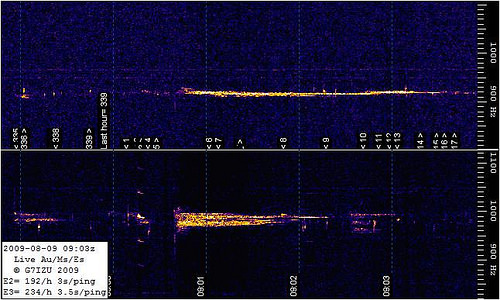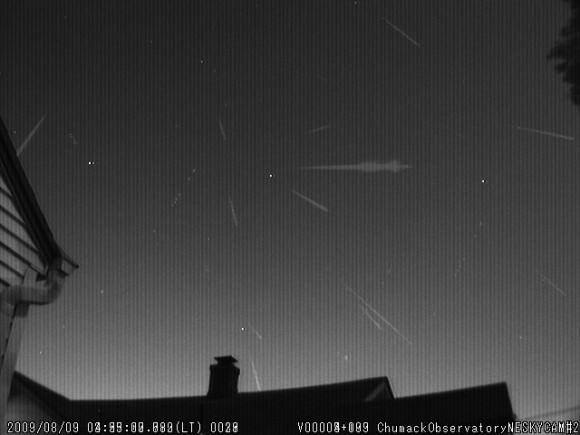Perseid Radio Astronomy from the Fourth Plinth With Chris Lintot
Within hours, the peak of the annual Perseid meteor shower will begin. If you're worried you'll be clouded out, then let's take a look at a different way that you can observe the activity… without your eyes! (...)
Read the rest of Perseid Radio Astronomy from the Fourth Plinth With Chris Lintott (493 words)
Watching Science in Action on Mars
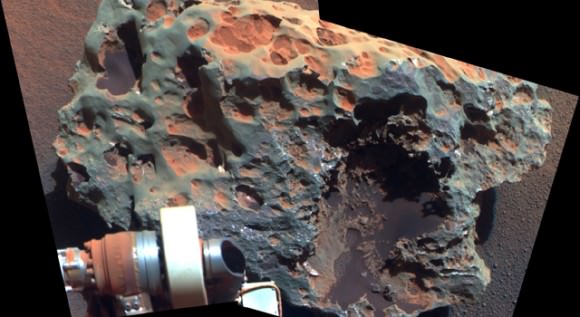
One of the great things about the Mars Exploration Rovers is that we get to see these scrappy little vehicles ramble across the surface of Mars, and watch science in action. Case in point: the meteorite found by Opportunity, dubbed "Block Island." Scientists are debating all sorts of things about this watermelon-sized rock. How old is it? What is it made of? Where could it have come from? But not only are we learning about this alien rock, we're also learning about the Red Planet itself and its environmental history.
See below for a new 3-D version of Block Island created by Stu Atkinson.
(...)
Read the rest of Watching Science in Action on Mars (599 words)
2009 Perseid Meteor Shower – Double Peaks This Year!
Are you ready for this year's Perseid Meteor Shower? What will be the best place to watch and when will be the best date to see the most "shooting stars"? Follow along and let's find out… (...)
Read the rest of 2009 Perseid Meteor Shower – Double Peaks This Year! (753 words)
Early Black Holes Are Starving, Not Feasting
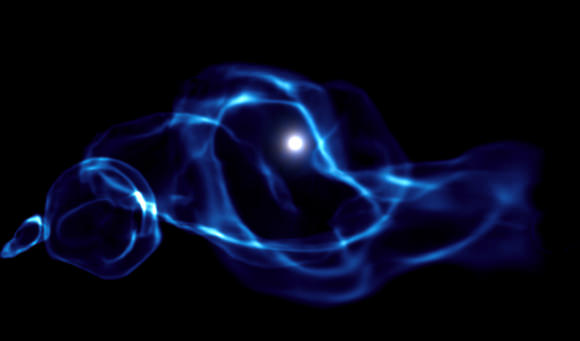
Credit: KIPAC/SLAC/M. Alvarez, T. Abel and J. Wise
A new black hole may not voraciously devour nearby gas — because it may kick out most of the gas in its neighborhood, a new study shows.
(...)
Read the rest of Early Black Holes Are Starving, Not Feasting (508 words)
Sun, Earth Are Unlikely Pair to Support Life
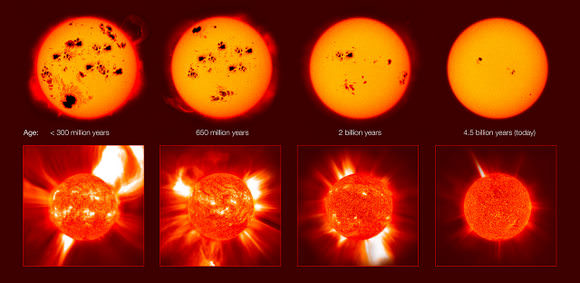
The violent youth of solar proxies. Courtesy of IAU.
We don't know how lucky we are — really.
We know the interaction between Earth and the Sun is a rarity in that it allowed life to form. But scientists working to understand the possibility that it could have happened elsewhere in the Universe are still far from drawing conclusions.
What is becoming clearer is that life probably shouldn't have formed here; the Earth and Sun are unlikely hosts.
(...)
Read the rest of Sun, Earth Are Unlikely Pair to Support Life (804 words)
NASA Science News for August 10, 2009
Like bugs streaking down the side window of a moving car, colorful Perseid Earthgrazers could put on a pleasing show after sunset on Tuesday, August 11th.
FULL STORY at
http://science.nasa.gov/headlines/y2009/10aug_horseflies.htm?list1035898
NASA Science News for August 7, 2009
The International Space Station's new "space porch" is open for business. Barely two weeks after it was installed by the crew of space shuttle Endeavour, the Japanese-built platform is already bustling with experiments in astronomy and space physics--and that's just for starters.
FULL STORY at
http://science.nasa.gov/headlines/y2009/07aug_spaceporch.htm?list1035898
Near-Earth Object Has Two Moons
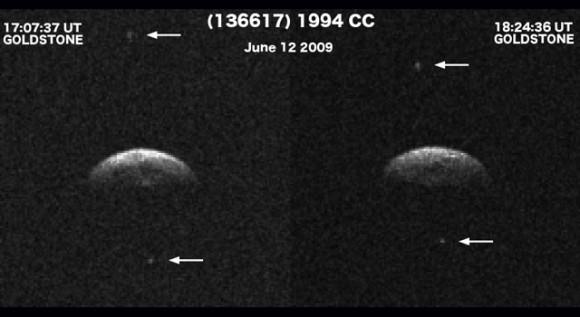
Radar images have shown that a near-Earth object is actually a triple system; an asteroid with two small moons. NASA's Goldstone Solar System Radar on June 12 and 14, 2009, revealed the new informaton about Asteroid 1994 CC. It came within 2.52 million kilometers (1.56 million miles) on June 10. Prior to the flyby, very little was known about this celestial body. 1994 CC is only the second triple system known in the near-Earth population. A team led by Marina Brozovic and Lance Benner, both scientists at NASA's Jet Propulsion Laboratory in Pasadena, Calif., made the discovery.
(...)
Read the rest of Near-Earth Object Has Two Moons (170 words)
Red Hot News… Possible Nova in Sagittarius!
 According to AAVSO Special Notice #164 just sent, there is a possible nova candidate in Sagittarius. It was discovered by Koichi Nishiyama, Kurume, Fukuoka-ken, Japan, and Fujio Kabashima, Miyaki-cho, Saga-ken, Japan, at unfiltered magnitude 7.7 on two 60-second frames taken Aug. 6.494 and 6.495 UT. They confirmed the discovery on five frames taken around Aug. 6.494. (...)
According to AAVSO Special Notice #164 just sent, there is a possible nova candidate in Sagittarius. It was discovered by Koichi Nishiyama, Kurume, Fukuoka-ken, Japan, and Fujio Kabashima, Miyaki-cho, Saga-ken, Japan, at unfiltered magnitude 7.7 on two 60-second frames taken Aug. 6.494 and 6.495 UT. They confirmed the discovery on five frames taken around Aug. 6.494. (...)
Read the rest of Red Hot News… Possible Nova in Sagittarius! (284 words)
IYA Live Telescope Today: M11 and 47 Tucanae
![]() Did you get a chance to check out the IYA "Live" Telescope today? After a prolonged period of clouds and bad weather in Central Victoria, we at least had a partially clear night. Our two objects for the evening were Messier 11 and stunning globular cluster 47 Tucanae. If you didn't get a chance to see them, why not step inside? We're making popcorn and playing a re-run… (...)
Did you get a chance to check out the IYA "Live" Telescope today? After a prolonged period of clouds and bad weather in Central Victoria, we at least had a partially clear night. Our two objects for the evening were Messier 11 and stunning globular cluster 47 Tucanae. If you didn't get a chance to see them, why not step inside? We're making popcorn and playing a re-run… (...)
Read the rest of IYA Live Telescope Today: M11 and 47 Tucanae (346 words)
Titan Shaping Up to Look a Lot Like Pre-Life Earth
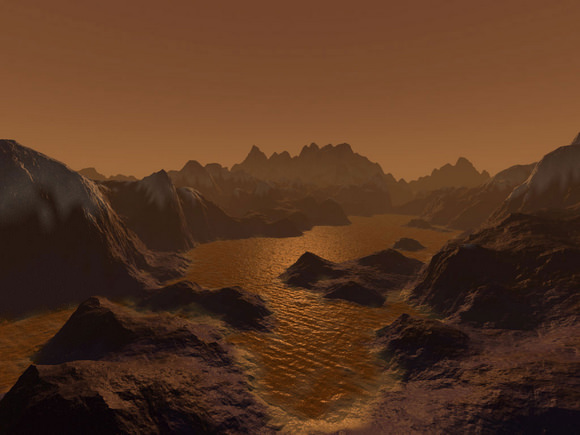
It's more than a billion kilometers (759 million miles) away, but the more astronomers learn about Titan, the more it looks like Earth.
That's the theme of two talks happening this week at the International Astronomical Union meeting in Rio de Janeiro, Brazil. Two NASA researchers, Rosaly Lopes and Robert M. Nelson of the Jet Propulsion Laboratory in Pasadena, California, are reporting that weather and geology have very similar actions on Earth and Titan — even though Saturn's moon is, on average, 100 degrees C (212 degrees F) colder than Antarctica (and certainly much more frigid than either California or Brazil; lucky astronomers).
The researchers are also reporting a tantalizing clue in the search for life: Titan hosts chemistry much like pre-biotic conditions on Earth.
(...)
Read the rest of Titan Shaping Up to Look a Lot Like Pre-Life Earth (567 words)
Ares I-X Comes Together (and it is BIG)
The Ares I-X rocket is being stacked on the Mobile Launch Platform in NASA's Vehicle Assembly Building in preparation for the rocket's first test flight, scheduled for October 31, 2009. The "super stack 1" was mated to the forward motor segment, and the rocket — which will stand at 99 meters (327 feet) — is now more than half way assembled. Assembly is done using a massive overhead crane, specially adapted for I-X use.
For comparison, the space shuttle stands at 56.1 m (184 ft), the Saturn V rocket was 110.6 m (363 ft), and the Ares V will be 116 m (380 ft) high.
See more images of the rocket below.
(...)
Read the rest of Ares I-X Comes Together (and it is BIG) (242 words)
New View Toward Carina Reveals Star Fest, Exploding "Engine"
 A remarkable new view of the Milky Way toward the constellation Carina is alive with a flurry of stars — and the pièce de résistance is a binary star that's all dressed up in a nebula of its own making.
A remarkable new view of the Milky Way toward the constellation Carina is alive with a flurry of stars — and the pièce de résistance is a binary star that's all dressed up in a nebula of its own making.
The European Southern Observatory (ESO) released the new images this week.
(...)
Read the rest of New View Toward Carina Reveals Star Fest, Exploding "Engine" (413 words)
There Was a Reason Discovery's Rollout Took Longer Than Usual…
Yikes! No wonder the rollout of space shuttle Discovery took a little bit longer than usual. Lightning lit up the sky above Kennedy Space Center early Tuesday morning, providing a stunning backdrop for the shuttle's crawl to the launchpad. Usually the trip takes about six hours, but various weather-related concerns slowed the move out past 11 hours. Lightning delayed Discovery's exit from the Vehicle Assembly Building for about 2 hours, and then mud from recent thunderstorms forced the crawler to stop repeatedly so engineers could clean out the giant treads on the huge 5.5 million-pound (2.4 million-kg) vehicle that hauls shuttles out to the launch pad. Discovery is scheduled to launch on August 25 for the STS-128 mission to the ISS. Of interest is that this mission will bring the C.O.L.B.E.R.T treadmill to the station, an exercise device named after comedian Stephen Colbert.
(...)
Read the rest of There Was a Reason Discovery's Rollout Took Longer Than Usual… (65 words)
Hubble, Gemini Spot 'Hyperactive' Stars in Small, Young Galaxies

We all know youngsters are a handful, but this really takes the cake: astronomers have clocked the speeds of stars in infant galaxies at about a million miles an hour, about twice the pace of our Sun's cruise through the Milky Way.
The small galaxies date to 11 billion years ago, when the universe was just a couple billion years old. Their stars, astronomers say, are buzzing and whirling at head-spinning rates.
(...)
Read the rest of Hubble, Gemini Spot 'Hyperactive' Stars in Small, Young Galaxies (354 words)
